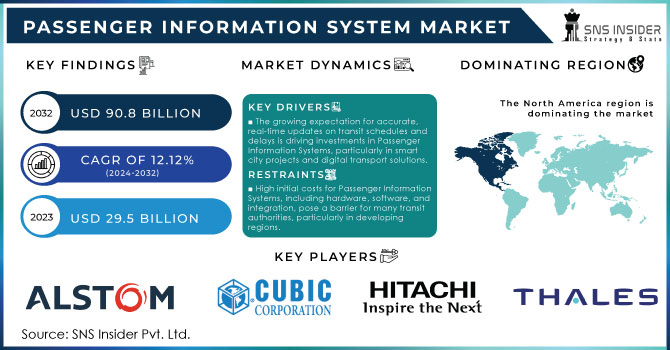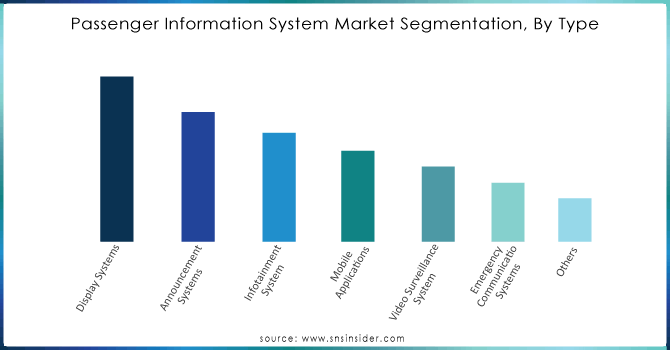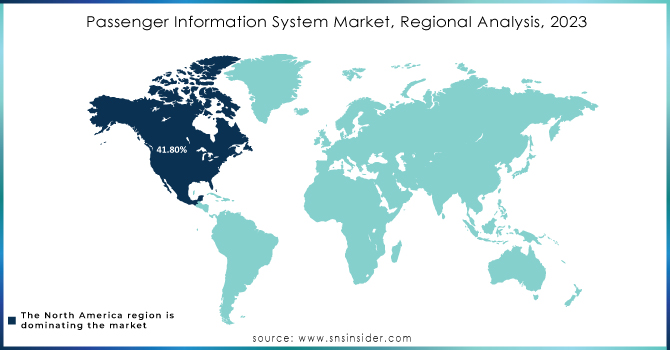Passenger Information System Market Key Insights:
The Passenger Information System Market size was valued at USD 29.5 Billion in 2023 and is expected to reach USD 90.8 Billion by 2032 and grow at a CAGR of 12.12% over the forecast period 2024-2032.

Get more information on Passenger Information System Market - Request Sample Report
Communities across the country are advocating for a transformative approach to public safety that prioritizes holistic, locally tailored, and community-led solutions. This shift calls for the rejection of outdated criminal justice policies reliant on aggressive enforcement and harsh penalties, which have failed to create lasting safety and have often harmed the very communities they aim to protect. Instead, leaders are urged to invest in prevention strategies that address the root causes of violence. This includes implementing diversion programs, providing support for individuals re-entering society after incarceration, and expanding services for crime survivors at risk of retaliation. Law enforcement should focus on effective crime-solving while avoiding over-policing, and fostering trust through community collaborations.
In 2023, the transportation landscape witnessed a notable shift, marked by the decline of futuristic projects like Hyperloop One, which aimed to transform mass transit with speeds of up to 700 miles per hour in sealed tubes. Despite the promise of revolutionary travel, the hyperloop's practicality and feasibility have been increasingly questioned, leading to its diminishing momentum in the United States. In stark contrast, traditional public transportation has experienced a renaissance, buoyed by renewed federal support and increased public investment. As a result, the reliance on static information displays has diminished, paving the way for more dynamic and personalized communication with passengers. Statistics indicate that the adoption of Passenger Information Systems has a direct positive impact on user satisfaction. A survey conducted in various metropolitan areas found that over 80% of commuters reported feeling more confident in their travel plans when provided with real-time information.
Additionally, the operational advantages of PIS cannot be overlooked. A study highlighted that transit agencies implementing advanced PIS experienced a reduction in delays by up to 30%. By effectively communicating service changes and expected arrival times, these systems reduce confusion and frustration among passengers, leading to smoother operations. Moreover, the incorporation of predictive analytics within PIS offers exciting prospects for the future. By analyzing historical data and current trends, transport authorities can forecast demand and adjust services proactively.
MARKET DYNAMICS
DRIVERS
-
The growing expectation for accurate, real-time updates on transit schedules and delays is driving investments in Passenger Information Systems, particularly in smart city projects and digital transport solutions.
The increasing demand for real-time information in public transportation is a significant driver of the Passenger Information System (PIS) market. Modern passengers rely on accurate and up-to-the-minute updates regarding their journeys, including arrival and departure times, potential delays, route changes, and platform adjustments. Studies show that 85% of public transport users prefer systems that provide real-time information, as it enables them to adjust their travel plans on the go and significantly reduces their wait times.
Furthermore, the impact of delays on passenger behavior is noteworthy. A survey conducted in major cities revealed that 73% of passengers are more likely to switch to public transport if real-time updates are available, particularly concerning delays and disruptions. This statistic underscores the importance of effective communication in attracting and retaining commuters. The rise of smart city initiatives has also amplified this demand. Currently, over 500 cities globally are investing in smart city projects, with transportation identified as a key focus area. A significant percentage of these projects involve the deployment of advanced PIS systems to provide real-time passenger information. This integration of digital technologies into public transport not only enhances the passenger experience but also contributes to the overall efficiency and effectiveness of urban mobility solutions. As urbanization continues to rise, the emphasis on real-time information systems will likely drive further innovation and widespread adoption of PIS technologies globally.
-
Global government funding for public transportation projects frequently includes Passenger Information Systems to boost efficiency and enhance the commuter experience in national rail and metro systems.
Government initiatives and funding play a crucial role in the advancement of public transportation systems, particularly through the implementation of Passenger Information Systems (PIS). Recognizing the importance of efficient and reliable public transit, many governments worldwide are investing heavily in infrastructure projects that enhance urban mobility. These investments often encompass the installation of PIS to provide passengers with timely and accurate information regarding arrival and departure schedules, delays, and service changes. For instance, national rail and metro projects in various countries have mandated the integration of PIS to streamline operations and significantly improve the commuter experience.
By enhancing the flow of information, PIS not only increases passenger satisfaction but also encourages greater use of public transportation, thereby alleviating congestion in urban areas and reducing the carbon footprint. Additionally, government funding supports the development of smart transportation solutions, aligning with broader goals of sustainability and innovation. Programs aimed at modernizing public transit often include substantial grants and financial assistance to local transit authorities, ensuring that they have the resources necessary to implement state-of-the-art PIS technologies. Furthermore, these initiatives promote collaboration between public and private sectors, fostering innovation and driving technological advancements in the transportation domain.
RESTRAIN
-
The high initial investment costs for comprehensive Passenger Information Systems (PIS) include expenses for hardware, software, and integration with existing infrastructure, posing a barrier for many transit authorities, especially in developing regions.
High initial investment costs are a substantial barrier to the implementation of comprehensive Passenger Information Systems (PIS) for many transit authorities, especially in developing regions. The deployment of these systems entails significant capital expenditure, which encompasses various components such as hardware, software, and the integration of new technologies with existing infrastructure. According to industry estimates, the average cost of a complete PIS can range from USD 1 million to over USD 5 million, depending on the system's complexity and scale.
Transit authorities must invest in advanced hardware, including digital displays, sensors, and communication devices, to ensure real-time information dissemination. This hardware can account for 40-60% of the total investment. Additionally, the software needed for data processing and user interfaces can be expensive, particularly if customized solutions are required to meet specific operational needs. Furthermore, integrating a PIS with pre-existing systems presents challenges, as it often involves additional costs related to compatibility upgrades, system testing, and potential disruptions to current services during installation, which can add another 20-30% to the overall budget. For many transit authorities, particularly those with limited budgets, these financial burdens can be prohibitive. The need to allocate substantial funds upfront can divert resources from other essential services or infrastructure improvements, ultimately hindering overall transit development. In developing regions, where budgets are already constrained, the challenge is even more pronounced, leading to delays in adopting modern technologies that could significantly enhance service quality and efficiency. Consequently, high initial investment costs not only impact the feasibility of implementing PIS but also perpetuate a cycle of underinvestment in essential transit infrastructure. This emphasizes the need for innovative funding solutions, such as public-private partnerships or government grants, to support the adoption of advanced transit technologies.
KEY SEGMENTATION ANALYSIS
By Type
In 2023, the display systems segment was the leading market player with a revenue share of 20.12%. Display systems act as the main connection between the transit authority and passengers. They give instant updates on timetables, delays, route modifications, and other important information. The timely information provided by these displays is essential for keeping operations efficient and improving user satisfaction.

Need any customization research on Passenger Information System Market - Enquiry Now
REGIONAL ANALYSIS
In 2023, the North America region dominated the market share over 41.80%, driven by the rise in urbanization leading to more urban migrations and a higher need for effective public transportation systems offering real-time information and information management. Furthermore, governmental efforts like the Bipartisan infrastructure plan have greatly supported the market in the area.
The Asia Pacific region is expected to grow at the fastest CAGR over 2024-2032. This can be attributed to the quick urban growth in the main emerging economies in the area, which has increased the need for PIS solutions. Moreover, the market has been changed through the integration of technologies like IoT and AI, which led to the distribution of passenger information, the provision of context-aware services, and customization.

KEY PLAYERS
Some of the major key players of Passenger Information System Market
-
Alstom (Passenger Information Displays, Communication Systems)
-
Cubic Corporation (NextBus Real-Time Information Systems)
-
Hitachi, Ltd. (Passenger Information Displays, Train Control Systems)
-
Indra Sistemas SA (Rail Information Solutions, Real-Time Passenger Information)
-
Mitsubishi Electric Corporation (Train Monitoring and Control Systems)
-
Siemens AG (Real-Time Passenger Information Systems, Rail Communication Solutions)
-
Singapore Technologies Electronics Limited (Passenger Information Displays, Integrated Solutions)
-
Teleste Corporation (Passenger Information Systems, Onboard Solutions)
-
Thales Group (Passenger Information Displays, Signalling Systems)
-
Toshiba Corporation (Passenger Information Systems, Data Solutions)
-
Wabtec Corporation (Passenger Information Displays, Train Control Solutions)
-
Altran Technologies (Real-Time Information Systems)
-
Advantech Co., Ltd. (Passenger Information Displays, Wireless Communication Solutions)
-
Luminator Technology Group (Passenger Information Systems, Display Solutions)
-
Neusoft Corporation (Real-Time Passenger Information Systems)
-
EKE-Electronics Ltd (Train Communication Networks, Passenger Information Solutions)
-
ICON Multimedia (Passenger Information Displays, Digital Signage Solutions)
-
Televic Rail (Passenger Information Systems, Rail Communication Solutions)
-
Tattile SRL (Automatic Passenger Counting Systems, Passenger Information Displays)
-
ST Engineering (Real-Time Passenger Information Systems, Public Transit Solutions)
RECENT DEVELOPMENTS
In October 2024: the Railway Board directed zonal officials to take action against those responsible for inaccurate train data in passenger information systems. This decision followed complaints about misleading information affecting passengers' travel experiences, underscoring the need for accuracy in data handling.
In October 2024: Wabtec announced a partnership with Siemens Mobility to provide passenger information systems for Munich's S-Bahn trains. This multi-million-euro agreement aims to enhance the passenger experience with real-time information and advanced technology in 90 new trains
| Report Attributes | Details |
|---|---|
| Market Size in 2023 | USD 29.5 Billion |
| Market Size by 2032 | USD 90.8 Billion |
| CAGR | CAGR of 12.12% From 2024 to 2032 |
| Base Year | 2023 |
| Forecast Period | 2024-2032 |
| Historical Data | 2020-2022 |
| Report Scope & Coverage | Market Size, Segments Analysis, Competitive Landscape, Regional Analysis, DROC & SWOT Analysis, Forecast Outlook |
| Key Segments | • By Type (Display Systems, Announcement Systems, Infotainment System, Mobile Applications, Video Surveillance System, Emergency Communication Systems, Others) • By Component (Solution, Services) • By System Location (On Board, In Station) • By Transportation Mode (Airway & Waterway, Railway, Roadway) |
| Regional Analysis/Coverage | North America (US, Canada, Mexico), Europe (Eastern Europe [Poland, Romania, Hungary, Turkey, Rest of Eastern Europe] Western Europe] Germany, France, UK, Italy, Spain, Netherlands, Switzerland, Austria, Rest of Western Europe]), Asia Pacific (China, India, Japan, South Korea, Vietnam, Singapore, Australia, Rest of Asia Pacific), Middle East & Africa (Middle East [UAE, Egypt, Saudi Arabia, Qatar, Rest of Middle East], Africa [Nigeria, South Africa, Rest of Africa], Latin America (Brazil, Argentina, Colombia, Rest of Latin America) |
| Company Profiles | Alstom, Cubic Corporation, Hitachi, Ltd., Indra Sistemas SA, Mitsubishi Electric Corporation, Siemens AG, Singapore Technologies Electronics Limited, Teleste Corporation, Thales Group, Toshiba Corporation, Wabtec Corporation, Altran Technologies, Advantech Co., Ltd., Luminator Technology Group, Neusoft Corporation, EKE-Electronics Ltd, ICON Multimedia, Televic Rail, Tattile SRL, and ST Engineering. |
| Key Drivers | • The growing expectation for accurate, real-time updates on transit schedules and delays is driving investments in Passenger Information Systems, particularly in smart city projects and digital transport solutions. • Global government funding for public transportation projects frequently includes Passenger Information Systems to boost efficiency and enhance the commuter experience in national rail and metro systems. |
| RESTRAINTS | • The high initial investment costs for comprehensive Passenger Information Systems (PIS) include expenses for hardware, software, and integration with existing infrastructure, posing a barrier for many transit authorities, especially in developing regions. |

